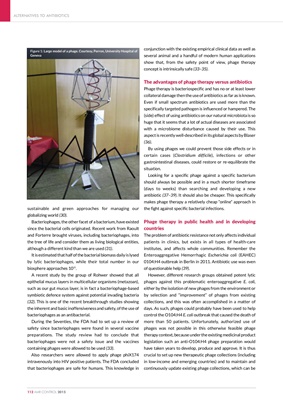
sustainable and green approaches for managing our
globalizing world (30).
Bacteriophages, the other facet of a bacterium, have existed
since the bacterial cells originated. Recent work from Raoult
and Forterre brought viruses, including bacteriophages, into
the tree of life and consider them as living biological entities,
although a different kind than we are used (31).
It is estimated that half of the bacterial biomass daily is lysed
by lytic bacteriophages, while their total number in our
biosphere approaches 10
31
.
A recent study by the group of Rohwer showed that all
epithelial mucus layers in multicellular organisms (metazoan),
such as our gut mucus layer, is in fact a bacteriophage-based
symbiotic defence system against potential invading bacteria
(32). This is one of the recent breakthrough studies showing
the inherent and basic inoffensiveness and safety, of the use of
bacteriophages as an antibacterial.
During the Seventies, the FDA had to set up a review of
safety since bacteriophages were found in several vaccine
preparations. The study review had to conclude that
bacteriophages were not a safety issue and the vaccines
containing phages were allowed to be used (33).
Also researchers were allowed to apply phage phiX174
intravenously into HIV positive patients. The FDA concluded
that bacteriophages are safe for humans. This knowledge in
conjunction with the existing empirical clinical data as well as
several animal and a handful of modern human applications
show that, from the safety point of view, phage therapy
concept is intrinsically safe (33-35).
The advantages of phage therapy versus antibiotics
Phage therapy is bacteriospecific and has no or at least lower
collateral damage then the use of antibiotics as far as is known.
Even if small spectrum antibiotics are used more than the
specifically targeted pathogen is influenced or hampered. The
(side) effect of using antibiotics on our natural microbiota is so
huge that it seems that a lot of actual diseases are associated
with a microbiome disturbance caused by their use. This
aspect is recently well-described in its global aspects by Blaser
(36).
By using phages we could prevent those side effects or in
certain cases (Clostridium difficile), infections or other
gastrointestinal diseases, could restore or re-equilibrate the
situation.
Looking for a specific phage against a specific bacterium
should always be possible and in a much shorter timeframe
(days to weeks) than searching and developing a new
antibiotic (37-39). It should also be cheaper. This specifically
makes phage therapy a relatively cheap "online" approach in
the fight against specific bacterial infections.
Phage therapy in public health and in developing
countries
The problem of antibiotic resistance not only affects individual
patients in clinics, but exists in all types of health-care
institutes, and affects whole communities. Remember the
Enteroaggregative Hemorrhagic Escherichia coli (EAHEC)
0104:H4 outbreak in Berlin in 2011. Antibiotic use was even
of questionable help (39).
However, different research groups obtained potent lytic
phages against this problematic enteroaggregative E. coli,
either by the isolation of new phages from the environment or
by selection and "improvement" of phages from existing
collections, and this was often accomplished in a matter of
days. As such, phages could probably have been used to help
control the O104:H4 E. coli outbreak that caused the death of
more than 50 patients. Unfortunately, authorized use of
phages was not possible in this otherwise feasible phage
therapy context, because under the existing medicinal product
legislation such an anti-O104:H4 phage preparation would
have taken years to develop, produce and approve. It is thus
crucial to set up new therapeutic phage collections (including
in low-income and emerging countries) and to maintain and
continuously update existing phage collections, which can be
ALTERNATIVES TO ANTIBIOTICS
112 AMR CONTROL 2015
Figure 1: Large model of a phage. Courtesy, Perron, University Hospital of
Geneva